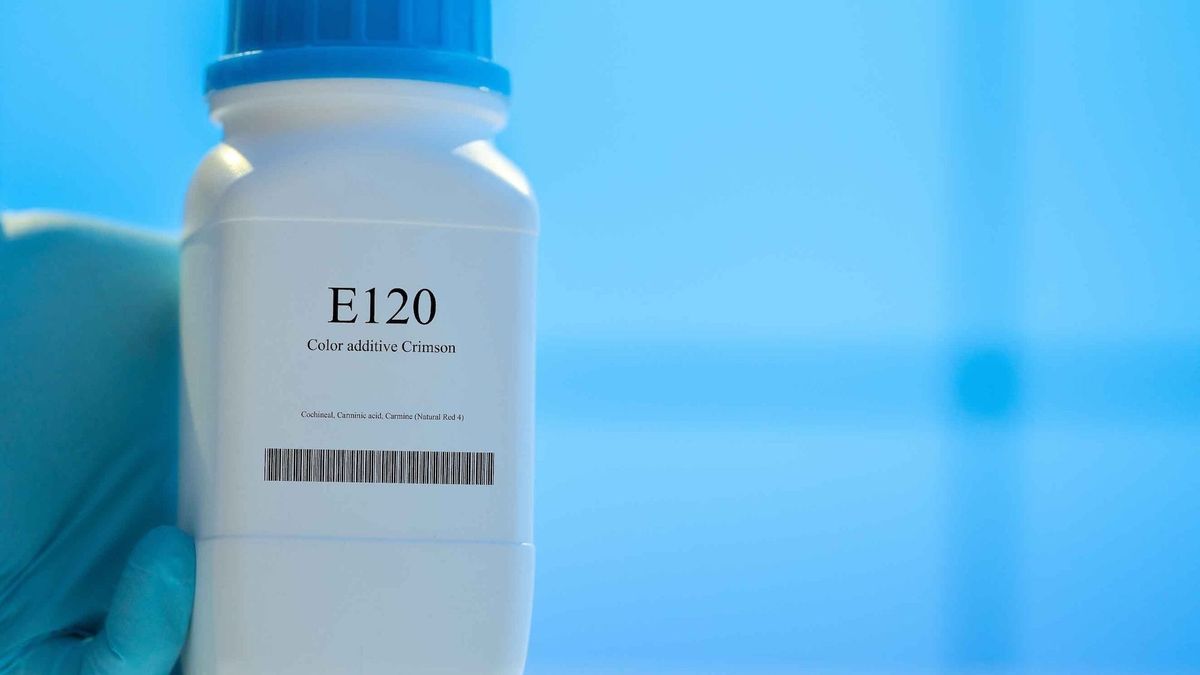
This coloring, present in many food products, provides a touch of color to make them more attractive to the consumer. But where does this additive come from? Is this colored pigment dangerous for health? In which food products is it added? We take stock.
Where does the E120 additive come from?
The E120 additive, also called carminic acid, is a coloring of natural origin, carmine red in color. This product is obtained from cochineal, Dactylopius cuckoo costa, a small parasitic insect from South America found in cacti. “Mealybugs are oval-shaped insects with soft bodies and flat scales. To protect itself from predators, this small insect, similar to aphids, secretes an acid, carminic acid, which, once the insect is crushed, reveals a red to purple color. To obtain the dye, female carmine-red scale insects are harvested, dried and then crushed to extract the carminic acid., explains Jimmy Thai, expert on food additive issues. This pigment is then reduced to a fine powder. It is water-soluble, meaning it dilutes easily in water. The majority of global production comes from Peru, Chile and the Canary Islands region of Spain.
What is E120 dye used for?
This pigment is used in different industrial sectors. Due to its red-purple color, it allows you to modify the color of a product or to reinforce its basic shade, in order to make the product more attractive to the buyer. Used since antiquity for dyes, this dye has since been widely used. It is found in certain medications, cosmetics such as eye shadow, eye pencils or even lipsticks as well as in certain everyday foods.
Unlike most other dyes, carmine E120 is remarkably stable, even at high temperatures. “This pigment resists light and oxidation well. Its coloring power is also very high, which explains why it is so commonly used in the food industry., specifies Jimmy Thai. On the other hand, it does not provide any flavor and does not modify the texture of the food.
In which food products is E120 added?
This red coloring is part of the list of additives authorized by the Codex Alimentarius (or Food Code), a joint program of the Food and Agriculture Organization of the United Nations (FAO) and the World Health Organization (WHO) which aims to specify standards, guidelines and other recommendations relating to consumer health safety.
“Around 320 food additives are currently authorized in foods in Europe, including the pigment E 120″, specifies Marie-Laure André, dietitian-nutritionist. This is the reason why this carmine coloring is present in many everyday industrial foods: fruit-flavored yogurts (and not the red color of red fruit yogurts such as strawberry and cherry does not come from the fruit itself). same), flavored industrial cheese, ice creams and water ices, confectionery, jams, tarama, soups, chewing gum, certain alcohols (dark red liquor), certain fruit juices , drinks such as syrups and red sodas, cream desserts, colorful pastries and biscuits, processed potato products, smoked fish, sauces such as chutney sauce, breakfast cereals , candied fruits, and cold meats such as sausages, Frankfurt sausage, merguez… to give them this pink shade so attractive to the consumer.
It is also possible to buy this water-soluble coloring (available in powder or liquid form) commercially and use it at home, to change the color of your food and bring. This acid can be added to your aqueous culinary preparations: sauces, macaroons, pancake batter, icings, drinks, etc.
How to spot this additive in food?
The presence of this carmine pigment from cochineal is indicated in the list of ingredients of the food product by the code E120 or the names “colorant: carminic acid”, “cochineal red”, “cochineal”. “Sometimes it is disguised as “natural coloring” or “coloring: carmine”“, adds Marie-Laure André. More difficult to find, this additive is also sometimes mentioned under the code names: “crimson lake”, “carmin lake”, “cochineal”, “natural red 4”, “carmins”, ” carmine”, “carmine red”, “cochineal carmine”, or even its chemical formula: “β-D-glucopyranosyl-7-tetrahydroxy-3,5,6,8-methyl-1-dioxo-9,10-antracenecarboxylic acid-2″.
Please note: the additive E120 is prohibited in organic food products.
Is this additive compatible with all diets?
Although natural, the pigment is extracted from the carmine red cochineal. Being an insect, therefore a small animal, the consumption of this coloring is therefore not compatible with vegetarian, vegan or vegan diets.
What are the authorized doses of E 120 additive?
Toxicity studies carried out by the FOA/WHO expert committee on food additives concluded at an acceptable daily intake (ADI) of 5 mg/kg body weight/day. But in 2015, EFSA carried out a new evaluation: the body then discovered that the admissible daily intake relates to pure carminic acid, even though it only constitutes half the mass of the food additive E120, in which it is usually associated with residues. Therefore, the body decides to revise the recommended quantity of this additive per day by dividing it by two, thus increasing the admissible daily dose to 2.5 mg per day and per kilo of body mass.1. The population exposure estimate remains below this limit.
Is the E120 additive dangerous for human health?
This pigment is not considered toxic to health. In the report drawn up by Efsa, the experts conclude that: “Acute, short-term, subchronic, carcinogenicity, reproductive and developmental toxicity studies conducted in rats or mice did not show toxicological potential.1.
NO to diets, YES to WW!
Are there any precautions to take when consuming E120 pigment?
“Although carmine is considered a safe food additive at the doses used, this acid may cause allergic reactions in some sensitive individuals.”explique Jimmy Thai. Indeed, the extraction process retains protein residues from the insect. These proteins are responsible for carmine-mediated IgE allergies. Symptoms may include hives, angioedema, asthma, difficulty breathing or even anaphylactic shock in the most serious cases“.
This is why in Europe, since 2009, regulations require that the presence of carmine be clearly mentioned in the list of ingredients. Carminic acid is also suspected of promoting hyperactivity in children.

